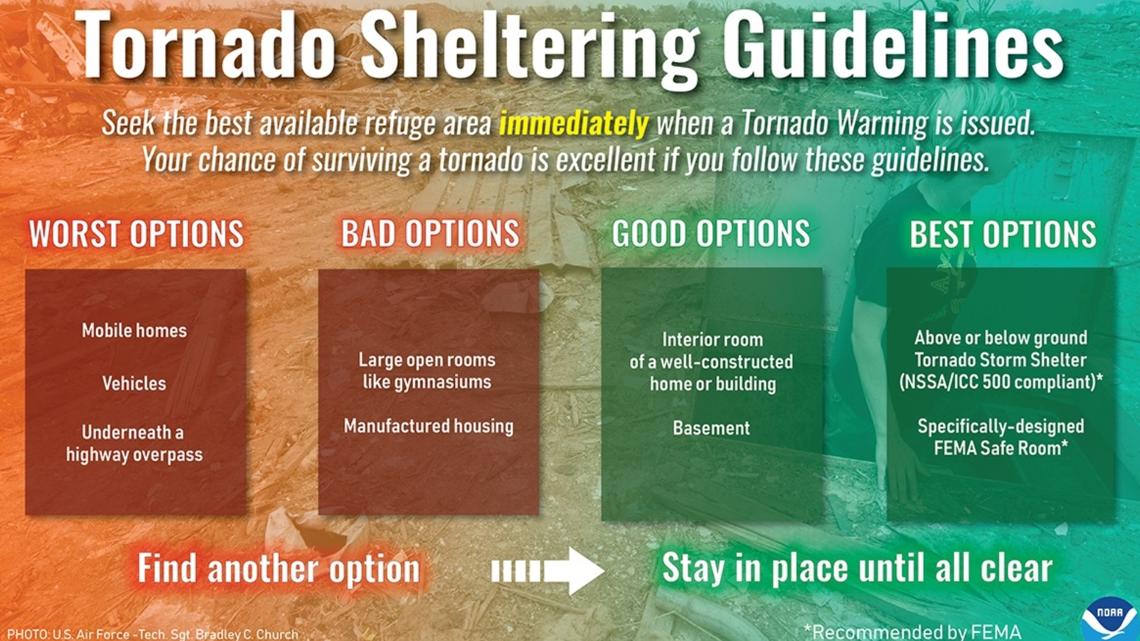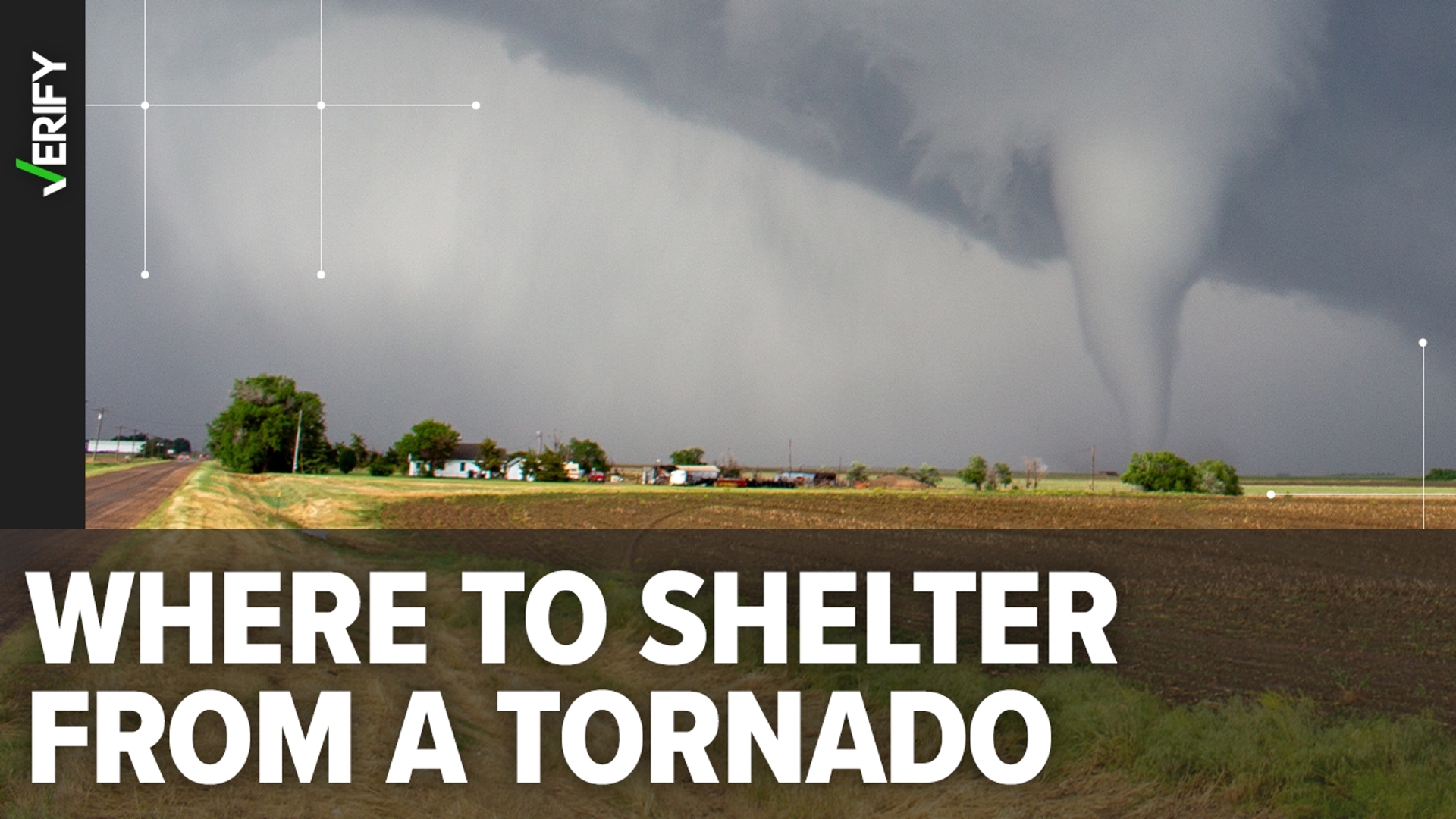CLEVELAND — Tornadoes can happen at any time and anywhere, including right here in Northeast Ohio. They can develop rapidly with little advanced warning.
The average lead time for a tornado warning is 10 to 15 minutes and winds can reach over 200 mph, which is why you need to prepare and make a plan before a tornado strikes.
Here are some terms you need to know and understand before the storm:
Tornado Watch: Tornadoes are possible. When there is a Watch, move near enough to a shelter or sturdy building to be able to get inside quickly if there is a Warning or if you see signs of a tornado approaching. Remain alert for approaching storms. Watch the sky and stay tuned to NOAA Weather Radio, commercial radio or television for information.
Tornado Warning: A tornado has been sighted or indicated by weather radar. Take shelter immediately.
Supercell: A system producing severe thunderstorms, featuring rotating winds sustained by a prolonged updraft that may result in hail or tornadoes.
BEFORE A TORNADO
- Identify safe rooms built to FEMA criteria or ICC500 storm shelters or other potential protective locations in sturdy buildings near your home, work, and other locations you frequent so you have a plan for where you will go quickly for safety when there is a Warning or an approaching tornado.
- For schools, malls, and other buildings with long-span roofs or open space plans, or many occupants, ask the building manager to identify the best available refuge.
- Build an emergency kit and make a family communications plan.
- Sign up for your community’s warning system. The Emergency Alert System (EAS) and National Oceanic and Atmospheric Administration (NOAA) Weather Radio also provide emergency alerts. If your community has sirens, become familiar with the warning tone.
- Listen to NOAA Weather Radio or to commercial radio or television newscasts for the latest information. Meteorologists can predict when conditions might be right for a tornado. In any emergency, always listen to the instructions given by local emergency management officials.
- Be alert to changing weather conditions. Look for approaching storms.
- Look for the following danger signs:
- Dark, often greenish sky
- Large hail
- A large, dark, low-lying cloud (particularly if rotating)
- Loud roar, similar to a freight train.
- If you see approaching storms or any of the danger signs, be prepared to take shelter immediately.
DURING A TORNADO
- If you are under a tornado warning, seek shelter immediately! Most injuries associated with high winds are from flying debris, so remember to protect your head.
- If you are in school, nursing home, hospital, factory, shopping center, high-rise building then:
- Go to a pre-designated area such as a safe room built to FEMA criteria, basement, storm shelter or the lowest building level. If there is no basement, go to the center of a smaller interior room, such as a closet or hallway, that is away from corners, windows, doors and outside walls. Put as many walls as possible between you and the outside. Get under a sturdy table and cover your head and neck with your arms and cover your body as best you can e.g., with a heavy coat or blankets, pillows.
- In a high-rise building, go to a small interior room or hallway on the lowest floor possible.
- Do not open windows.


People in mobile homes should go to a nearby building or underground shelter
If you live in a mobile home, our sources say you shouldn’t stay during a tornado since these homes can turn over during strong winds. Mobile homes built before 1976 are particularly vulnerable to high winds, NWS says.
“Even mobile homes with a tie-down system cannot withstand the force of tornado winds,” the CDC adds.
People who live in mobile homes need to go to a nearby building – preferably one with a basement – or an underground shelter.
If there isn’t shelter nearby, our sources recommend lying flat in the nearest ditch, ravine or culvert, and shielding your head with your hands.
AFTER A TORNADO
- If you are trapped, do not move about or kick up dust. If possible, cover your mouth with a cloth or mask to avoid breathing dust. Try to send a text, bang on a pipe or wall, or use a whistle instead of shouting.
- Keep listening to EAS, NOAA Weather Radio, and local authorities for updated information.
- Save your phone calls for emergencies. Phone systems are often down or busy after a disaster. Use text messaging or social media to communicate with family and friends.
- Watch out for debris and downed power lines.
- Stay out of damaged buildings and homes until local authorities indicate it is safe.
- Use extreme caution during post-disaster clean-up of buildings and around debris. Do not attempt to remove heavy debris by yourself. Wear protective clothing, including a long-sleeved shirt, long pants, work gloves, and sturdy, thick-soled shoes during clean-up.
- Do not enter buildings until you are told that they are safe.
- Photograph the damage to your property in order to assist in filing an insurance claim.
- Do what you can to prevent further damage to your property, (e.g., putting a tarp on a damaged roof), as insurance may not cover additional damage that occurs after the storm.
- If your home is without power, use flashlights or battery-powered lanterns rather than candles to prevent accidental fires.
- Check and restock your emergency supply kit.
MORE RESOURCES
WAYS TO GET WEATHER ALERTS
You should have multiple ways to stay weather aware and receive critical weather information:
1. NOAA Weather Radio
The first is NOAA Weather Radio. We often refer to them as the “smoke detector” for severe weather, because they will automatically sound an alarm in the case of a natural disaster or severe weather.
2. Local Broadcast
There is also always your local TV station. The 13 ON YOUR SIDE Weather Department streams on-air and online during an active storm.
Download the 13 ON YOUR SIDE app now. When you open the app, you can enable your location to be sent active alerts in your area.
You can see the latest severe weather alerts here.
3. Radio Station
Local radio stations should alert you if a storm is in your area. You can even set up devices like Alexa and Google Home to alert you with weather notifications.
4. Smartphone
Your smartphones also offer numerous ways to receive critical weather alerts. We have a 13 ON YOUR SIDE Weather App that will allow you to track the storm and receive alerts.
Download our weather app from the App Store for Apple Devices or for your Android device here.
5. Nixle Alerts
- Nixle is a FREE comprehensive warning system designed for rapid dissemination of alerts and public information to a variety of public mechanisms.
- Alerts and emergency information are received via text, email, web, and social media in real time for localized emergency situations relevant to the community.
- To register for NIXLE ALERTS
- Text your Zip Code to 888777
- Sign up and create a user profile at https://local.nixle.com/register/
6. Outdoor Sirens
Outdoor sirens are also an option, as they will go off in the threat of immediate danger, but are only meant to be heard outdoors. So, if you are inside, this should not be how you receive your severe weather alerts. Outdoor sirens can also be unreliable, difficult for those hard of hearing, and go off for other reasons beyond tornadoes.
NOAA Weather Radios:
- Are designed for All-Hazards Warning and can be modified to alert those with special needs including deaf and hard of hearing, blind, etc.
- Are programmed to notify you of hazards within your area including tornados, severe thunderstorms, straight-line winds, downbursts, hail, hazardous materials spills, floods, etc.
- Will give you specific information about the storm and emergency protective measures you should take.
- Are set off automatically through local NOAA Weather Radio Towers when a warning is issued. Notifications occur within seconds of the warning.
- Are battery operated and will work when there is no power. Some models are handheld while others are also an AM/FM radio and alarm clock.
- On average, cost $20.00 per unit. Units are no more expensive to maintain than smoke detectors.
ENHANCED FUJITA (EF) SCALE
After a tornado strikes, the National Weather Service surveys the impacted areas to determine the strength of the tornado. If they find evidence through photos, video and eye-witness accounts, they'll rate it on a scale called the EF scale.
Rates the strength of tornadoes in the United States and Canada. There are six categories for the EF scale and are in order of increasing intensity. *It is based on wind estimates of a 3 second gust.*
- EF0: Tornadoes with estimated wind speed of 65-85 mph and leads to light damage.
- EF1: Estimated wind speed of 86-110 mph with the potential of moderate damage.
- EF2: Estimated wind speeds of 111-135 mph with significant damage potential.
- EF3: Estimated wind speeds of 136-165 mph with severe damage potential.
- EF4: Estimated wind speeds of 166-200 mph with devastating damage potential.
- EF5: Estimated wind speeds of over 200 mph with incredible damage potential.

